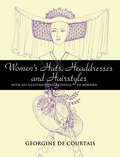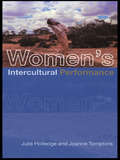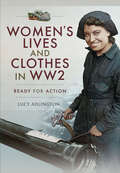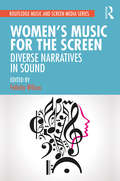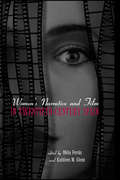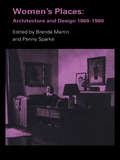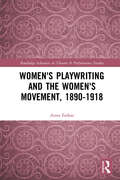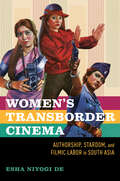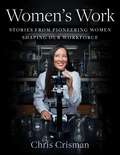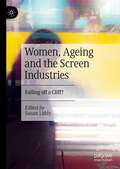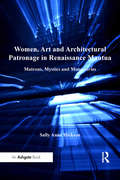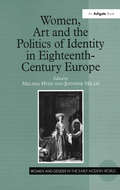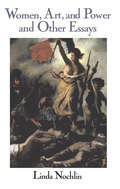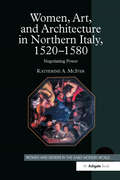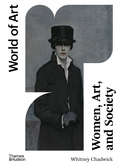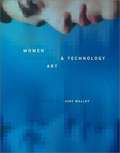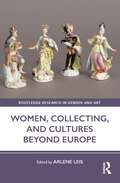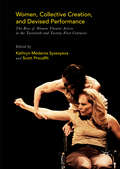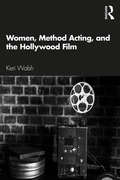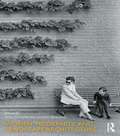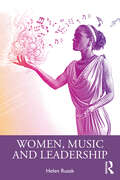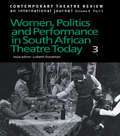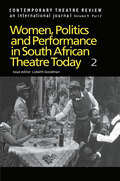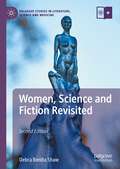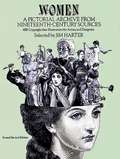- Table View
- List View
Women's Hats, Headdresses and Hairstyles: With 453 Illustrations, Medieval to Modern
by Georgine De CourtaisFrom simple barbettes, crespines, and wimples worn in Anglo-Saxon times to the pillbox hat popularized by Jackie Kennedy in the mid-twentieth century, hats and headdresses have -- for centuries -- played an important part of a lady's wardrobe. This informative and meticulously researched book provides an authentic record of more than 1,300 years of changing fashions in women's hairstyles and headwear in England.More than 400 of the author's own drawings -- rendered from ancient sources -- trace these evolving fashions. Finely detailed images depict turbans; horned, heart-shaped, and butterfly headdresses preferred by fifteenth-century English ladies; seventeenth-century hoods and veils; elaborate hats and hairstyles of the Georgian period; early Victorian-era bonnets; net and lace caps and small hats of the late nineteenth century; and the emancipated look in both hairstyles and hat styles of the early twentieth century.The author has written a separate introduction for each historical period, placing headdresses and hairstyles in the fashionable context of their time. Pages of drawings are accompanied by detailed notes on the styles illustrated, including information on the materials used and the varying methods of manufacture. A brief glossary and bibliography add to the book's effectiveness. For those who want to get their historical details accurate, this profusely illustrated guide will be an invaluable reference. "Designers for any media and students of history will use and enjoy the book." (Choice). "Remarkably entertaining." (The Economist)
Women's Intercultural Performance
by Julie Holledge Joanne TompkinsThis is the first in-depth examination of contemporary intercultural performance by women around the world. Contemporary feminist performance is explored in the contexts of current intercultural practices, theories and debates. Holledge and Tompkins provide ways of thinking about and analysing contemporary performance and representations of the performing, female, culturally-marked body. The book includes discussions of: * ritual performance by women from Central Australia and Korea * the cultural exchange of A Doll's House and Antigone * plays from Algeria, South Africa and Ghana * the work of the Takarazuka revue company * the market forces that govern the distribution of women and women's performance. This is an essential read for anyone studying or interested in women's performance.
Women's Lives and Clothes in WW2: Ready for Action
by Lucy AdlingtonAn illustrated history of World War II-era women&’s fashions, featuring ladies from all nations involved in conflict. What would you wear to war? How would you dress for a winter mission in the open cockpit of a Russian bomber plane? At a fashion show in Occupied Paris? Singing in Harlem, or on fire watch in Tokyo? Women&’s Lives and Clothes in WW2 is a unique, illustrated insight into the experiences of women worldwide during World War II and its aftermath. The history of ten tumultuous years is reflected in clothes, fashion, accessories, and uniforms. As housewives, fighters, fashion designers, or spies, women dressed the part when they took up their wartime roles. Attractive to a general reader as well as a specialist, Women&’s Lives and Clothes in WW2 focuses on the experiences of British women, then expands to encompass every continent affected by war. Woven through all cultures and countries are common threads of service, survival, resistance, and emotion. Historian Lucy Adlington draws on interviews with wartime women, as well as her own archives and costume collection. Well-known names and famous exploits are featured—alongside many never-before-told stories of quiet heroism. You&’ll indulge in luxury fashion, bridal ensembles, and enticing lingerie, as well as thrifty make-do-and-mend. You&’ll learn which essential garments to wear when enduring a bomb raid and how a few scraps of clothing will keep you feeling human in a concentration camp. Women's Lives and Clothes in WW2 is richly illustrated throughout, with many previously unpublished photographs, 1940s costumes, and fabulous fashion images. History has never been better dressed.
Women's Music for the Screen: Diverse Narratives in Sound
by Felicity WilcoxWomen’s Music for the Screen: Diverse Narratives in Sound shines a long-overdue light on the works and lives of female-identifying screen composers. Bringing together composer profiles, exclusive interview excerpts, and industry case studies, this volume showcases their achievements and reflects on the systemic gender biases women have faced in an industry that has long excluded them. Across 16 essays, an international array of contributors present a wealth of research data, biographical content, and musical analysis of film, television, and video game scores to understand how the industry excludes women, the consequences of these deficits, and why such inequities persist – and to document women’s rich contributions to screen music in diverse styles and genres.The chapters amplify the voices of women composers including Bebe Barron, Delia Derbyshire, Wendy Carlos, Anne Dudley, Rachel Portman, Hildur Guðnadóttir, Mica Levi, Winifred Phillips, and more. From the mid-twentieth century to the present, and from classic Hollywood scores to pioneering electronic music, these are the stories and achievements of the women who have managed to forge successful careers in a male-dominated arena. Suitable for researchers, educators, and students alike, Women’s Music for the Screen urges the screen music industry to consider these sounds and stories in a way it hasn’t before: as voices that more accurately reflect the world we all share.
Women's Narrative and Film in 20th Century Spain
by Kathleen GlennWomen's Narrative and Film in 20th Century Spain examines the development of the feminine cultural tradition in spain and how this tradition reshaped and defined a Spanish national identity. Each chapter focuses on representation of autobiography, alienation and exile, marginality, race, eroticism, political activism, and feminism within the ever-changing nationalisms in different regions of Spain. The book describes how concepts of gender and difference shaped the individual, collective, and national identities of Spanish women and significantly modified the meaning and representation of female sexuality.
Women's Places: Architecture and Design 1860-1960
by Penny Sparke Brenda MartinWhat was different about the environments that women created as architects, designers and clients at a time when they were gaining increasing political and social status in a male world? Through a series of case studies, Women's Places: Architecture and Design 1860-1960, examines in detail the professional and domestic spaces created by women who had money and the opportunity to achieve their ideal. Set against a background of accepted notions of modernity relating to design and architecture of the late 19th and early 20th centuries, this book provides a fascinating insight into women's social aspirations and identities. It offers new information and new interpretations in the study of gender, material culture and the built environment in the period 1860-1960.
Women's Playwriting and the Women's Movement, 1890-1918 (Routledge Advances in Theatre & Performance Studies)
by Anna FarkasThe influence of the women’s movement has long been a scholarly priority in the study of British women’s drama of the late nineteenth and early twentieth centuries, but previous scholarship has largely clustered around two events: the New Woman in the 1890s and the suffrage campaign in the years before the First World War. Women’s Playwriting and the Women’s Movement, 1890–1918 is the first designated study of British women’s drama from a period of exceptional productivity and innovation for female playwrights. Both the British theatre and women’s position within British society underwent fundamental changes in this period, and this book shows how female dramatists carefully negotiated their position in the heated debates about women’s rights that occurred at this time, while staking out a place for themselves in an evolving theatrical landscape. Farkas also identifies the women’s movement as a key influence on the development of female-authored drama between 1890 and 1918, but argues that scholarly prioritizing of the "radicalism" of work associated with the New Woman and the suffrage campaign has had a distorting effect in the past. Ideal for scholars of British and Victorian theatre, Women’s Playwriting and the Women’s Movement, 1890–1918 offers a new perspective which emphasizes the complexity of women playwrights’ engagement with first-wave feminism and links it to the diversification of the British theatre in this period.
Women's Transborder Cinema: Authorship, Stardom, and Filmic Labor in South Asia (Women’s Media History Now!)
by Esha Niyogi DeCan we write women’s authorial roles into the history of industrial cinema in South Asia? How can we understand women’s creative authority and access to the film business infrastructure in this postcolonial region? Esha Niyogi De draws on rare archival and oral sources to explore these questions from a uniquely comparative perspective, delving into examples of women holding influential positions as stars, directors, and producers across the film industries in India, Pakistan, and Bangladesh. De uses film tropes to examine the ways women directors and film entrepreneurs claim creative control within the contexts of anti-colonial nationalism and global capitalism. The region’s fictional cinemas have become staging grounds for postcolonialism, with colonial and local hierarchies merged into new imperial formations. De’s analysis shows how the gendered intersections of inequity and opportunity shape women’s fiction filmmaking while illuminating the impact of state and market formations on the process. Innovative and essential, Women’s Transborder Cinema examines the works of South Asia’s women filmmakers from a regional perspective.
Women's Work: Stories from Pioneering Women Shaping Our Workforce
by Chris Crisman&“A beautiful book that provides genuine encouragement and inspiration. Vivid portrait photography and accompanying essays declare that all work is women's work.&” —Kirkus Reviews (starred review) In this stunning collection, award-winning photographer Chris Crisman documents the women who pioneered work in fields that have long been considered the provinces of men—with accompanying interviews on how these inspiring women have always paved their own ways. Today, young girls are told they can do—and be—anything they want when they grow up. Yet the unique challenges that women face in the workplace, whether in the boardroom or the barnyard, have never been more publicly discussed and scrutinized. With Women&’s Work, Crisman pairs his award-winning, striking portrait photography of women on the job with poignant, powerful interviews of his subjects: women who have carved out unique places for themselves in a workforce often dominated by men, and often dominated by men who have told them no. Through their stories, we see not only the ins and outs of their daily work, but the emotional and physical labors of the jobs they love. Women&’s Work is a necessary snapshot of how far we&’ve come and where we&’re heading next—their stories are an inspiration as well as a call to action for future generations of women at work. Women&’s Work features more than sixty beautiful photographs, including Alison Goldblum, contractor; Anna Valer Clark, ranch owner; Ayah Bdeir, CEO of littleBits; Beth Beverly, taxidermist; Carla Hall, blacksmith; Cherise Van Hooser, funeral director; Jordan Ainsworth, gold miner; Magen Lowe, correctional officer; Mindy Gabriel, firefighter; Nancy Poli, pig farmer; Katherine Kallinis Berman and Sophie Kallinis LaMontagne, Founders of Georgetown Cupcake; Doris Kearns Goodwin, presidential biographer; Sophi Davis, cowgirl; Abingdon Welch, pilot; Christy Wilhelmi, beekeeper; Connie Chang, chemical engineer; Danielle Perez, comedienne; Indra Nooyi, former CEO of PepsiCo; Lisa Calvo, oyster farmer; Mia Anstine, outdoor guide; Meejin Yoon, architect; Yoky Matsuoka, a tech VP at Google; and many more.
Women, Ageing and the Screen Industries: Falling off a Cliff?
by Susan LiddyThis book explores the challenges facing women from their mid-forties as they attempt to build/maintain careers in the screen industries. Essays are concerned with the intersection of gender and age on screen and behind the camera and how that can create a ‘double jeopardy’. Existing research in this area has been primarily directed to onscreen representation. Female actors, with notable exceptions, struggle to get screen time and expansive roles as they age. Behind the camera, women 45+ also face challenges and roadblocks; to date, less attention has been directed to this group. The cross-cultural research in this collection offers an analysis of representation, on and off screen, touching on film, television, streaming services and film festivals. It includes an exploration of gendered ageism, age bias and stereotyping. It also highlights the achievements of mature female practitioners who, in their work and working lives, embody a resistance to restrictive cultural discourses about ageing women.
Women, Art and Architectural Patronage in Renaissance Mantua: Matrons, Mystics and Monasteries (Women and Gender in the Early Modern World)
by Sally Anne HicksonAnalyzing the artistic patronage of famous and lesser known women of Renaissance Mantua, and introducing new patronage paradigms that existed among those women, this study sheds new light the social, cultural and religious impact of the cult of female mystics of that city in the late fifteenth and early sixteenth century. Author Sally Hickson combines primary archival research, contextual analysis of the climate of female mysticism, and a re-examination of a number of visual objects (particularly altarpieces devoted to local beatae, saints and female founders of religious orders) to delineate ties between women both outside and inside the convent walls. The study contests the accepted perception of Isabella d'Este as a purely secular patron, exposing her role as a religious patron as well. Hickson introduces the figure of Margherita Cantelma and documents concerning the building and decoration of her monastery on the part of Isabella d'Este; and draws attention to the cultural and political activities of nuns of the Gonzaga family, particularly Isabella's daughter Livia Gonzaga who became a powerful agent in Mantuan civic life. Women, Art and Architectural Patronage in Renaissance Mantua provides insight into a complex and fluid world of sacred patronage, devotional practices and religious roles of secular women as well as nuns in Renaissance Mantua.
Women, Art and the Politics of Identity in Eighteenth-Century Europe (Women and Gender in the Early Modern World)
by Melissa HydeThe eighteenth century is recognized as a complex period of dramatic epistemic shifts that would have profound effects on the modern world. Paradoxically, the art of the era continues to be a relatively neglected field within art history. While women's private lives, their involvement with cultural production, the project of Enlightenment, and the public sphere have been the subjects of ground-breaking historical and literary studies in recent decades, women's engagement with the arts remains one of the richest and most under-explored areas for scholarly investigation. This collection of new essays by specialist authors addresses women's activities as patrons and as "patronized" artists over the course of the century. It provides a much needed examination, with admirable breadth and variety, of women's artistic production and patronage during the eighteenth century. By opening up the specific problems and conflicts inherent in women's artistic involvements from the perspective of what was at stake for the eighteenth-century women themselves, it also acts as a corrective to the generalizing and stereotyping about the prominence of those women, which is too often present in current day literature. Some essays are concerned with how women's involvement in the arts allowed them to fashion identities for themselves (whether national, political, religious, intellectual, artistic, or gender-based) and how such self-fashioning in turn enabled them to negotiate or intervene in the public domains of culture and politics where "The Woman Question" was so hotly debated. Other essays examine how men's patronage of women also served as a vehicle for self-fashioning for both artist and sponsor. Artists and patrons discussed include: Carriera; Queen Lovisa Ulrike and Chardin; the Bourbon Princesses Mlle Clermont, Mme Adélaïde and Nattier; the Duchess of Osuna and Goya; Marie-Antoinette and Vigée-Lebrun; Labille-Guiard; Queen Carolina of Naples, Prince Stanislaus Poniatowski of Poland and Kauffman; David and his students, Mesdames Benoist, Lavoisier and Mongez.
Women, Art, And Power And Other Essays
by Linda NochlinWomen, Art, and Power?seven landmark essays on women artists and women in art history?brings together the work of almost twenty years of scholarship and speculation.
Women, Art, and Architecture in Northern Italy, 1520–1580: Negotiating Power (Women and Gender in the Early Modern World)
by Katherine A. McIverExpanding interdisciplinary investigations into gender and material culture, Katherine A. McIver here adds a new dimension to Renaissance patronage studies by considering domestic art - the decoration of the domestic interior - as opposed to patronage of the fine arts (painting, sculpture and architecture). Taking a multidimensional approach, McIver looks at women as collectors of precious material goods, as organizers of the early modern home, and as decorators of its interior. By analyzing the inventories of women's possessions, McIver considers the wide range of domestic objects that women owned, such as painted and inlaid chests, painted wall panels, tapestries, fine fabrics for wall and bed hangings, and elaborate jewelry (pendant earrings, brooches, garlands for the hair, necklaces and rings) as well as personal devotional objects. Considering all forms of patronage opportunities open to women, she evaluates their role in commissioning and utilizing works of art and architecture as a means of negotiating power in the court setting, in the process offering fresh insights into their lives, limitations, and the possibilities open to them as patrons. Using her subjects' financial records to track their sources of income and the circumstances under which it was spent, McIver thereby also provides insights into issues of Renaissance women's economic rights and responsibilities. The primary focus on the lives and patronage patterns of three relatively unknown women, Laura Pallavicina-Sanvitale, Giacoma Pallavicina and Camilla Pallavicina, provides a new model for understanding what women bought, displayed, collected and commissioned. By moving beyond the traditional artistic centers of Florence, Venice and Rome, analyzing instead women's artistic patronage in the feudal courts around Parma and Piacenza during the sixteenth century, McIver nuances our understanding of women's position and power both in and out of the home. Carefully integrating extensive archival
Women, Art, and Society (World of Art #0)
by Whitney ChadwickA new edition of the groundbreaking book by Whitney Chadwick maps the complete history of women artists from the Middle Ages and the Renaissance to today. Art historian Whitney Chadwick’s acclaimed bestselling study challenges the assumption that great women artists are exceptions to the rule who “transcended” their gender to produce major works of art. While introducing some of the many women since the Middle Ages whose contributions to visual culture have often been neglected, Chadwick’s survey reexamines the works themselves and the ways in which they have been perceived as marginal, often in direct reference to gender. In her discussion of feminism and its influence on such a reappraisal, she also addresses the closely related issues of ethnicity, class, and sexuality. This revised edition features a completely redesigned interior and full-color illustrations. With a new preface and epilogue from this emerging authority on the history of women artists, curator and professor Flavia Frigeri, this revised edition continues the project of charting the evolution of feminist art history and pedagogy, revealing how artists have responded to new strategies of feminism for the current moment.
Women, Art, and Technology
by Judy MalloyAlthough women have been at the forefront of art and technology creation, no source has adequately documented their core contributions to the field.
Women, Collecting, and Cultures Beyond Europe (Routledge Research in Gender and Art)
by Leis ArleneThis book examines collecting around the world and how women have participated in and formed collections globally. The edited volume builds on recent research and offers a wider lens through which to examine and challenge women’s collecting histories. Spanning from the seventeenth century to the twenty-first (although not organized chronologically) the research herein extends beyond European geographies and across time periods; it brings to light new research on how artificiallia and naturallia were collected, transported, exchanged, and/or displayed beyond Europe. Women, Collecting and Cultures Beyond Europe considers collections as points of contact that forged transcultural connections and knowledge exchange. Some authors focus mainly on collectors and what was collected, while others consider taxonomies, travel, patterns of consumption, migration, markets, and the after life of things. In its broad and interdisciplinary approach, this book amplifies women’s voices, and aims to position their collecting practices toward new transcultural directions, including women’s relation to distinct cultures, customs, and beliefs as well as exposing the challenges women faced when carving a place for themselves within global networks. This study will be of interest to scholars working in collections and collecting, conservation, museum studies, art history, women’s studies, material and visual cultures, Indigenous studies, textile histories, global studies, history of science, social and cultural histories.
Women, Collective Creation, and Devised Performance
by Kathryn Mederos Syssoyeva Scott ProudfitThis book explores therole and centrality of women in the development of collaborative theatrepractice, alongside the significance of collective creation and devising in thedevelopment of the modern theatre. Tracing a web of women theatremakers in Europeand North America, this book explores the connections between early twentiethcentury collective theatre practices such as workers theatre and the dramaticplay movement, and the subsequent spread of theatrical devising. Chaptersinvestigate the work of the Settlement Houses, total theatre in 1920s' France,the mid-century avant-garde and New Left collectives, the nomadic performancesof Europe's transnational theatre troupes, street-theatre protests, andcontemporary devising. In so doing, the book further elucidates a history of moderntheatre begun in A History of CollectiveCreation (2013) and CollectiveCreation in Contemporary Performance (2013), in which the seeminglymarginal and disparate practices of collective creation and devising arerevealed as central--and women theatremakers revealed as progenitors of thesepractices.
Women, Method Acting, and the Hollywood Film
by Keri WalshWomen, Method Acting, and the Hollywood Film is the first study dedicated to understanding the work of female Method actors on film. While Method acting on film has typically been associated with the explosive machismo of actors like Marlon Brando and Robert De Niro, this book explores an alternate tradition within the Method—the work that women from the Actors Studio did in Hollywood. Covering the period from the end of the Second World War until the 1970s, this study shows how the women associated with the Actors Studio increasingly used Method acting in ways that were compatible with their burgeoning feminist political commitments and developed a style of feminist Method acting. The book examines the complex intersection of Method acting, sexuality, and gender by analyzing performances such as Kim Hunter’s in A Streetcar Named Desire, Julie Harris’s in The Member of the Wedding, Shelley Winters’s in The Big Knife, Geraldine Page’s in Sweet Bird of Youth, and Jane Fonda’s in Coming Home. Challenging the longstanding assumption that Method acting’s approaches were harmful to women and incompatible with feminism, this book argues that some of Hollywood’s most interesting female actors, and leading feminists, emerged from the Actors Studio in the period between the 1950s and the 1970s. Written for students and scholars of Film Studies, Cultural Studies, Theatre and Performance Studies, and Gender Studies, Women, Method Acting, and the Hollywood Film reshapes the way we think of a central strain in American screen acting, and in doing so, allows women a new stake in that tradition.
Women, Modernity, and Landscape Architecture
by Sonja Dümpelmann John BeardsleyModernity was critically important to the formation and evolution of landscape architecture, yet its histories in the discipline are still being written. This book looks closely at the work and influences of some of the least studied figures of the era: established and less well-known female landscape architects who pursued modernist ideals in their designs. The women discussed in this volume belong to the pioneering first two generations of professional landscape architects and were outstanding in the field. They not only developed notable practices but some also became leaders in landscape architectural education as the first professors in the discipline, or prolific lecturers and authors. As early professionals who navigated the world of a male-dominated intellectual and menial work force they were exponents of modernity. In addition, many personalities discussed in this volume were either figures of transition between tradition and modernism (like Silvia Crowe, Maria Teresa Parpagliolo), or they fully embraced and furthered the modernist agenda (like Rosa Kliass, Cornelia Oberlander). The chapters offer new perspectives and contribute to the development of a more balanced and integrated landscape architectural historiography of the twentieth century. Contributions come from practitioners and academics who discuss women based in USA, Canada, Brazil, New Zealand, South Africa, the former USSR, Sweden, Britain, Germany, Austria, France and Italy. Ideal reading for those studying landscape history, women’s studies and cultural geography.
Women, Music and Leadership
by Helen RusakWomen, Music and Leadership offers a wide-ranging survey of women in musical leadership and their experiences, highlighting women’s achievements and considering how they negotiate the challenges of the leadership space in music. Women have always participated in music as performers, teachers, composers and professionals, but remain underrepresented in leadership positions. Covering women’s leadership across a wide variety of roles and musical genres, this book addresses women in classical music, gospel, blues, jazz, popular music, electronic music and non-Western musical contexts, and considers women working as composers, as conductors, and in music management and the music business. Each chapter includes several case studies of women’s careers, exploring their groundbreaking contributions to music and the challenges they faced as leaders. Connecting management theory and leadership research with feminist musicology, this book paints a new picture of women’s major contributions as leaders in music and their ongoing struggles for equity. It will be relevant to students and scholars in arts and music management, as well as all those studying music, gender or leadership, and women music professionals.
Women, Politics and Performance in South African Theatre Today Vol 3: Volume 3 (Contemporary Theatre Review Ser. #Vols. 9, Pts. 3.)
by Lizbeth GoodmanThis title available in eBook format. Click here for more information.Visit our eBookstore at: www.ebookstore.tandf.co.uk.
Women, Politics and Performance in South African Theatre Today: Volume 2
by Goodman LFirst Published in 1999. Routledge is an imprint of Taylor & Francis, an informa company.
Women, Science and Fiction Revisited (Palgrave Studies in Literature, Science and Medicine)
by Debra Benita ShawWomen, Science and Fiction Revisited is an analysis of selected science fiction novels and short stories written by women over the past hundred years from the point of view of their engagement with how science writes the world. Beginning with Charlotte Perkins Gilman's Herland (1918) and ending with N K Jemisin's The City We Became (2020), Debra Benita Shaw explores the re-imagination of gender and race that characterises women's literary crafting of new worlds. Along the way, she introduces new readings of classics like Ursula Le Guin's The Left Hand of Darkness and Margaret Atwood's The Handmaid's Tale, examining the original novels in the context of their adaptation to new media formats in the twenty-first century. What this reveals is a consistent preoccupation with how scientific ideas can be employed to challenge existing social structures and argue for change.
Women: A Pictorial Archive from Nineteenth-Century Sources
by Jim HarterLush allegorical ladies, Grecian maids and Victorian maidens, Indians, Japanese, dancers, housewives, courtesans; women dancing, smiling, working, weeping, flirting — an unusually rich sourcebook of feminine poses and activities, costumes, clothing, everyday life, and much more. Images selected from rare issues of Leslie's Weekly, The London Illustrated News, The Graphic, and more. 488 illustrations.
